Dancing with the Zapatistas
Diana Taylor
An earlier version of this essay appeared in The Routledge Companion to Art and Politics (2015) under the title "Living Politics: The Zapatistas Celebrate their Twentieth Anniversary."
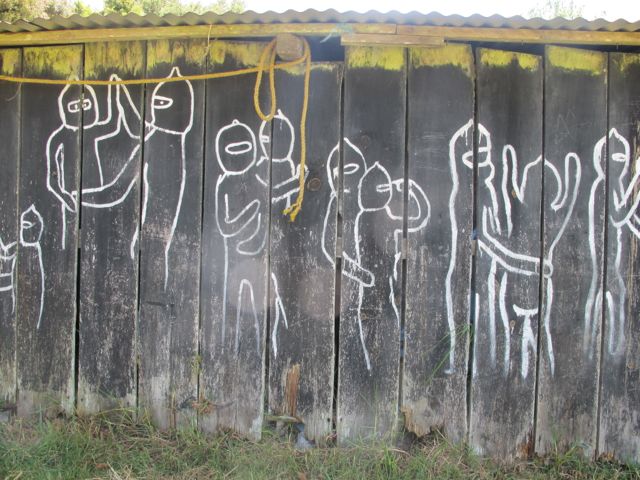
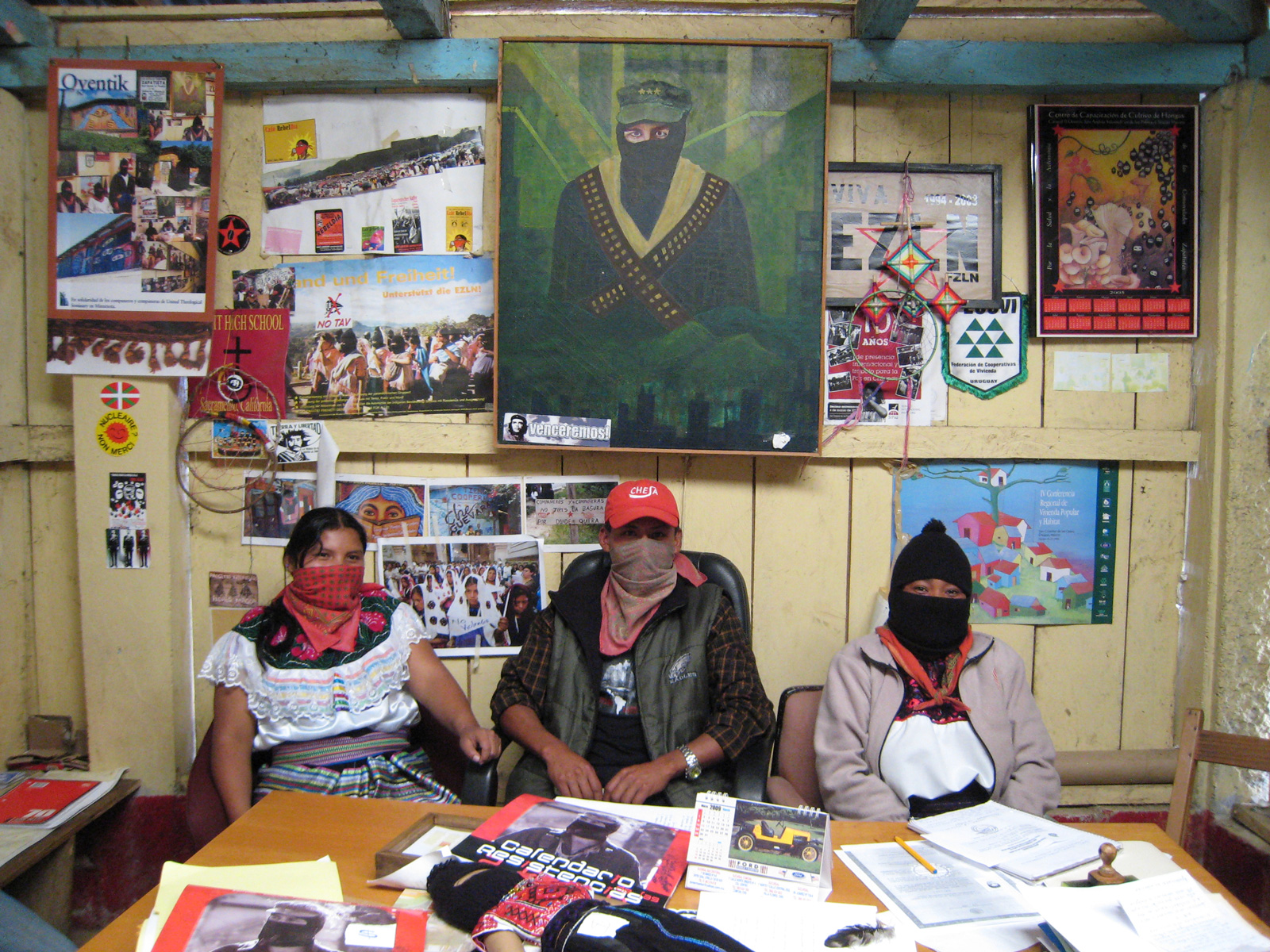
San Cristóbal de las Casas, situated in the Mayan highlands in the southern Mexico state of Chiapas, was alive with visitors and independent journalists from all over the world. 1,500 people had been admitted to the escuelita this time, including major figures in human rights and education.[2] A similar number attended via video conferencing from Centro Indigena de Capacitacion Integral (the Indigenous Center for Holistic Training, or CIDECI), a local Zapatista-inspired university. For the celebration of the caracoles, vans, trucks, and cars were lined up far along the road that goes past Oventic, the caracol closest to San Cristóbal de las Casas, and thus, the most visited. A sign on the road said:
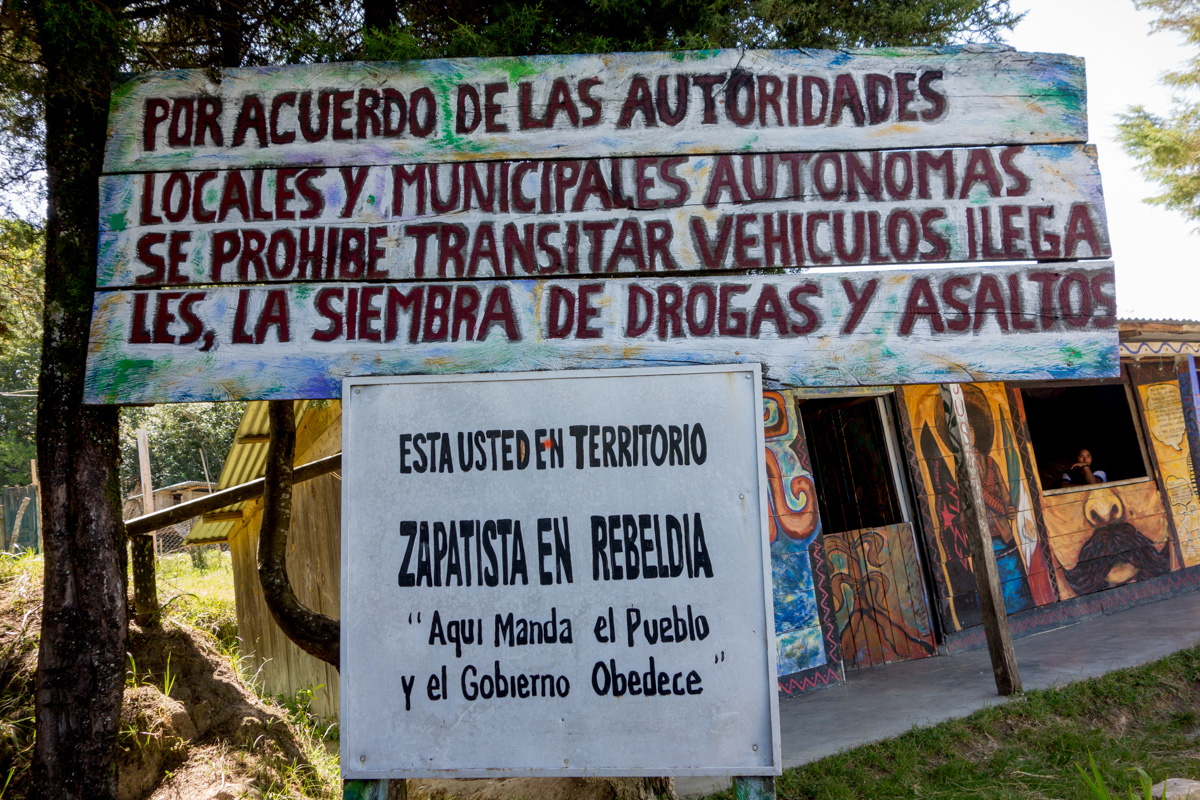
ESTA USTED EN TERRITORIO
ZAPATISTA EN REBELDIA
“Aquí manda el pueblo
y el gobierno obedece”
ZAPATISTA EN REBELDIA
“Aquí manda el pueblo
y el gobierno obedece”
YOU ARE IN ZAPATISTA REBEL TERRITORY
“Here the people decide
and the government obeys”
We crowded together, waiting, as a masked Zapatista asked to see our IDs. We provided the list of our participants from all over the Americas—Venezuela, Colombia, Argentina, Chile, Peru, Brazil, Mexico, the US, and Canada. One participant came from Uganda, two from Spain, and another one from Australia. Three in our group were indigenous Mayan women who participated as artists in our program. The man looked at us, decided not to count, and went off with the list. Another came close to keep an eye of us. One of the women in our group said something to him, and he smiled through his ski mask. He wanted to know where we were from and why we wanted to be there, a good question that I will come back to later. “To celebrate,” was all we said.
Chiapas provides a remarkable arena to study art and resistance for several reasons, most notably because the Zapatistas’ are the experts on resistance.[4] They have tried all sorts of strategies—from the initial armed warfare of early 1994, to negotiations with the "bad" government that produced the San Andrés Accords, guaranteeing autonomy and rights to indigenous peoples, to the loss of faith in the Mexican government that failed to honor the Accords, to the formation of an alternative "good" government and autonomous administrative centers in 2003, to the national marches throughout the country that make visible the Zapatista claims to justice and dignity, (Vera 2001) to closing the caracoles off from the world, to opening them to national and international supporters, to the invitation to celebrate and attend their escuelitas that brought us to Oventic.
On the Zapatista’s Little School of Freedom: A Student's Notes
Read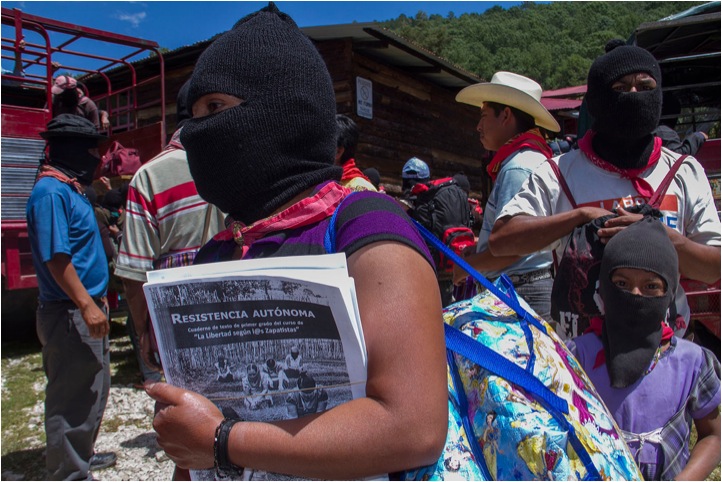
NAFTA, the North American Free Trade Agreement, was simply the last straw. But they adapt, they say, “para no dejar de ser” (so as not to cease being) historical beings. The bottom line, using John Holloway’s terminology, is that indigenous communities’ power to live, work, and flourish has been under constant attack by the government’s power over their life, work, and well-being. How can resistance counter this making vulnerable? And what, to rephrase the Zapatistas' question to us, were we doing there? (Holloway 2002, 12)
Part of our being there, in the language of the academe, had to do with practice-based research. Theorists in performance studies have learned this methodology from artistic practice: an artist knows through doing. For us, it meant using embodied experience and practice—being there—as an entry point for learning and theorizing, and not just the other way around. In other words, our presence, acts, and interactions could produce new ways of knowing and theorizing that would be different than, say, learning from the findings of others through lectures or articles. Walking, spatially situating ourselves in relation to and with others, speaking and participating with them, moving through (rather than distancing themselves from) the space and events, might allow for a grounded theory. “To be me,” an Aymara saying goes, “I have to walk and speak with others.”[5]
I AM-A Poetic Conversation
ReadClearly, the process is complex and murky—we always act from a position of prior assumptions and knowledge and tend to write about what we "know," not necessarily what we experience. The Zapatistas might be the product of decades (if not centuries) of networking and community building, but we visitors bring our own networks of interlocutors, theories, and practices that accompany us wherever we go. Metaphorically, we arrived with our backpacks crammed with texts, theories, preconceptions, expectations, fears, doubts, and so on. In this sense, therefore, we, too, were (and are always) masked, hiding our assumptions and sensibilities behind a visible willingness to transcend them. The hope of practice-based research might be that the we who engage in the practice are not the same we who emerge from it.
This practice-based approach, moreover, affects the way that I am writing up these experiences and findings and transmitting them to others. Instead of resisting the urge to avoid descriptive passages––a style long abhorred by critical theorists, including myself––I need to outline the events to convey the basis for the critical reflections that follow. Yet even in outlining events, it’s clear as I move through that what I see, and do, and feel is already a product of the social systems of which I am a part. I cannot leave my formation of self behind any more than I can shed my skin––that is, very gradually, if at all. In that sense, we can never experience wholly what is out there—but that too becomes part of the reflection.
So please bear with me.
We waited under the tarp outside the Che Guevara gift shop and snack bar that bridges the caracol and the highway. Families of indigenous peoples steadily moved past us towards the party. While some Mayans wore western-type clothing—pants and sweatshirts––many were dressed in the native clothing from their various villages. The women from Chamula wore the thick black lambskin skirts and lovely embroidered tops from the highlands under thin acrylic sweaters in all colors against the cold and rain. Those from Zinacantán wore the beautiful blue and purple tops from their village, and there were many other patterns from other regions that I could not identify (Morris 2012).
To this day, the embroidery communicates meaning (some related to astronomy, others to the ancient Mayan systems of time, others more contemporary) to other indigenous peoples capable of deciphering them––“hidden transcripts” as James C. Scott calls them, but in textiles (1990, 4-5). Yet the face remains covered, illegible in Scott’s framework. All adults covered their faces. Bodily practices and the aesthetics of the everyday, for the Zapatistas, are never removed from politics. The sartorial style, especially the ski mask and/or the paliacate, the red bandana they wear, defined all of them as Zapatistas.
My particular backpack weighs me down with writings on and about the face—Levinas, Artaud, Deleuze and Guattari, Butler, Taussig, to name a few. But now, I am in the midst of hundreds of masked people going about the ordinary rituals of a communal celebration—announcing themselves as part of the community, easily identifying each other, and yet remaining anonymous to us, the outsiders, all at the same time. Words and phrases ring in my mind: “[f]aces are not basically individual, they define zones” (Deleuze and Guattari 1987, 168) and so on—but nothing helps.
I know I have to bracket my theoretical reflections and put them away for later. Now, I have to interact, even if I do not fully understand.
EZLN Women's Revolutionary Law
ReadPeople bought food or soft drinks at the entrance before heading down to the large congregation area. No alcohol is allowed in any Zapatista community as decreed by the Women’s Revolutionary Law of 1993. Our group seemed content to wait, odd for people in their twenties and thirties who had enough social mobility to travel to Chiapas.
Reflection One: Waiting
This was not the first time the Zapatistas had kept us waiting. Two days earlier we had visited Oventic during the daytime after obtaining permission two months earlier through a written request accompanied by Xeroxes of everyone’s passports. When we arrived, two men and a woman received us as the gate. Each, of course, was wearing a ski mask on the hot August morning. I handed over a list with everyone’s name and country of origin, along with the passports and photocopies. The woman began painstakingly writing down every name on the list, inquiring about country of origin, and about our interest in the community. “Why copy everything down when they have the list?” someone from our group asked. Mayan technology, I thought. Every community needs to administer information in its own way and control entrances and exits.
Zapatista Muralism and the Making of a Community
ReadThe process here moved through the body of this very small woman. Her inquiries were hard for me to understand, and she would repeat them patiently. Spanish was not her first language. She probably spoke Tzotzil or Tzeltal, the two dominant linguistic groups in the region. Writing, too, required concentrated bodily effort judging from her focus in forming the words. Every once in a while one of the men would take the list down the hill to one of the buildings that lined both sides of the straight long road. We looked at the buildings visible from the road—the grade school
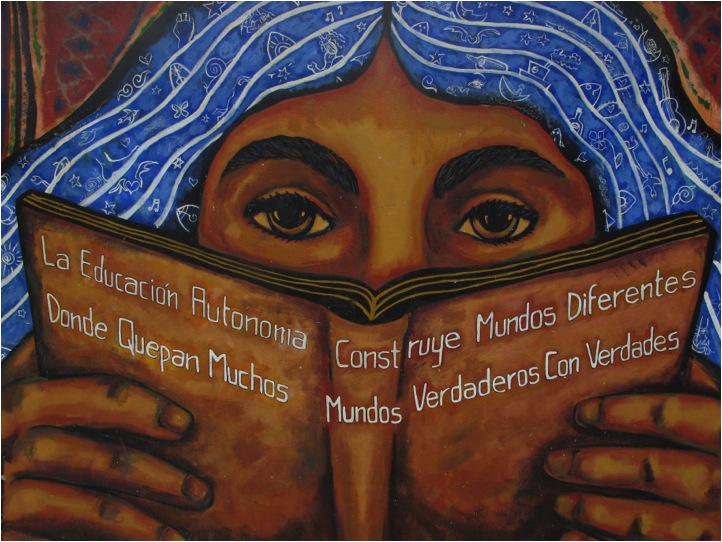
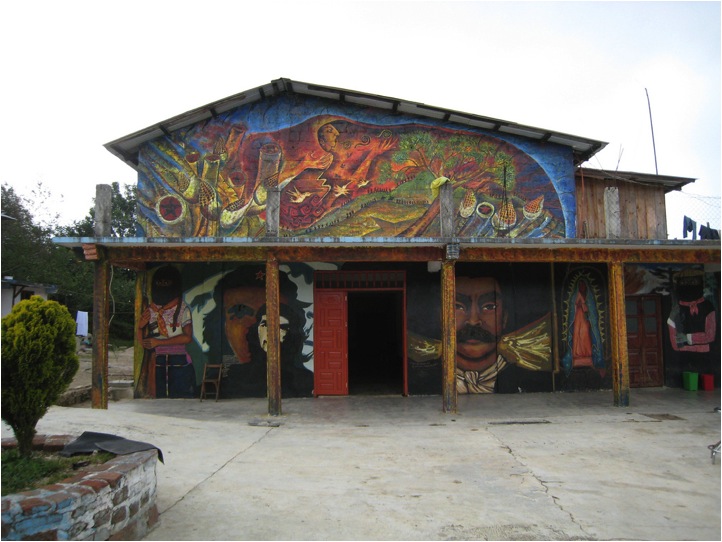
So we sat. We would take turns buying water from the small Che Guevara store that faced out to the road as well as into the caracol. After two and half hours, we were invited to enter. No one complained. We were there to try to understand resistance, and the Zapatistas knew all about durational performance. 500 years and counting. While the presupposition is that resistance entails action, just as importantly, we were learning, it also entails waiting. They have waited and waited. We, who came racing from the realm of instantaneous time and gratification that characterizes globalization, stopped: we do not always control the time, space, and conditions of our actions. Lesson one from the Zapatistas.
Now, on that rainy night two days later, the wait seemed longer. After 15 minutes or so I began to wonder if we would be refused entrance to this party. Every caracol has a do not admit list, but we knew from our earlier visit that no one in our group was on it. We’d get in, I reassured myself—we just had to wait. As before, we understood the politics of waiting, and we experienced, yet again, the reversal in terms of control and access. The Zapatistas have the authority. This is their land; we are the visitors. For a population as subjugated as the Mayans have been in Chiapas, this was a notable reversal.
50 years ago, indigenous people (who made up 25% of the state’s population), were not allowed to walk on the sidewalks of San Cristóbal or enter its banks. Chiapas was the poorest state in the Mexico and had the highest level of illiteracy (Ríos 2014). Women and children carried heavy bundles of wood on their backs to spare the donkeys. Young girls could be sold or bartered away. All of this officially tolerated in the name of tradition. Comandanta Esther, the first indigenous woman to address the Mexican legislature, said, “we know which are the good uses of ‘tradition’ and which the bad" (quoted in Monsiváis 2003, 47). The Zapatistas mandate equality. Even standing at the entrance to the caracol, the comportment of Zapatista women entering the space made it clear that here women were treated as equals, although they continued to bear the enormous domestic burdens of their foremothers.
Soon we were granted admission and started our way down the hill. The music reverberated from the loudspeakers. All the buildings that lined the road were open to serve the visitors. Plastic tarps outfitted with faint lightbulbs lined the long road down. Wet wooden benches tottered close to the long tables covered with baskets of food. It was so dark I could barely see. I switched on the flashlight app on my iPhone and hoped the battery would last. Would I be able to charge it here? I felt ridiculous, aware of how I gauged my vulnerability as linked to my dependency on digital technology (and other things I carry around with me in my metaphorical and “real” backpack) for navigating the world I live in.
The heavy rains had washed out the road that just two days earlier had been so firmly packed with gravel. After the rains were over the Zapatistas would start, once more, to fix it. Vendors nursed fires to heat enormous aluminum pots of water. Others roasted corn on the cob on metal grills; people ate them topped with mayonnaise, grated cheese, and chili (as I always had as a child from the north of Mexico). Others were selling atole, a warm corn beverage dating back to pre-conquest times. People crowded around small stands to buy tacos and tamales. Pyramids of soft drinks lined the outer perimeters of makeshift tables. The caracol, so empty two days before, now had thousands of people milling around in the dark and pouring rain.
Over the loudspeakers we could hear a soft male voice making announcements in the various indigenous languages. Some words, bases de apoyo (grass root supporters) and bueno, kept cropping up in all languages. When the announcements began in Spanish, I realized he was inviting us all to gather on the cancha (the basketball court). The official part of the celebration was about to begin.
The cancha was lined on one side by a covered platform and an enormous Mexican flag tacked to the wall. A smaller black flag with "EZLN" (Ejército Zapatista de Liberación Nacional, or Zapatista Army of National Liberation) in red letters around the centered red star hung beside it.
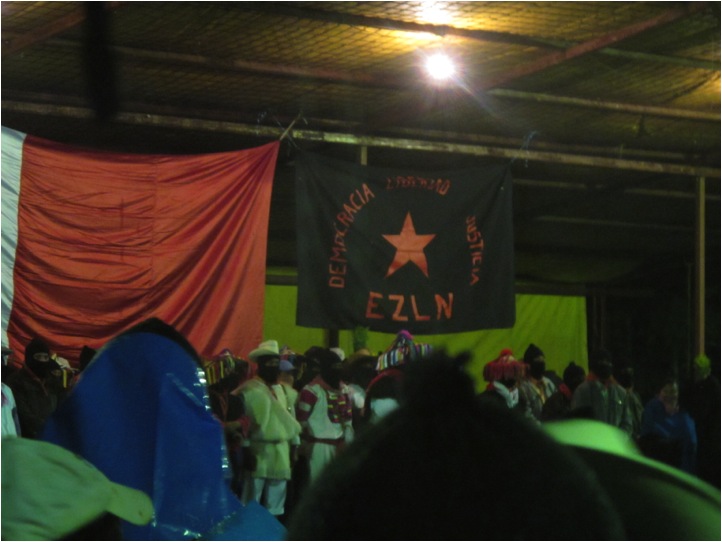
The official ceremony began when a long line of civic representatives from the various Zapatista communities walked onto the platform—about 30 or 40 men and women dressed in traditional indigenous dress. White and black sheepskin tunics for the men. They wore straw hats with colorful ribbons hanging over their ski masks, and on their feet, they wore huaraches: leather, open-toed sandals with rubber bottoms made from worn out tires. Women wore skirts, the embroidered blouses, and black plastic sandals. The several Zapatistas marched with the Mexican and EZLN flags around the courtyard and stood firmly in place. The opening ceremony emphasized the “armed struggle” nature of the movement, though it had been nearly 20 years since the Zapatistas had taken up weapons. Yet the E of EZLN stands for ejercito, or army. I had overlooked that, focused as I had always been on the cultural aspects of resistance. The E reminded us of the stakes.
Those who refuse to recognize the power of the state need to be prepared to fight and even die. When the national anthem came over the loudspeakers, young Zapatistas raised their arms in military salute. They, too, are "mexicanos al grito de guerra"––"Mexicans at the cry of war" (Mexico’s belligerent national anthem). The opening ceremony was all about military gestures. But clearly, the battle was not against Mexico—every act repeated their love for their country. Their fight was against the national government and political parties that had over and again broken treaties and betrayed indigenous rights.
And the Silence Became Poetry and Mexico Listened
ReadReflection Two: "Good" and "Bad" Governments
The entrance to the “rebel territory” marks the line between two interconnected political systems: both performatic, both masked. The Zaptatistas’ political project was not “indigenous” in form or content—it was the age-old struggle for "good" government. On one side, the "bad" neoliberal government (I agree with the Zapatistas here) characterized by violence, corruption, and greed. The other "good" in that it examines the basic mechanisms of existing power (not as a thing one has but as a practice of social relations, i.e. power over) and asks: Who exerts it? Who decides? Who gets left out? They then transform those practices and relationships into their core principles:
a. Participatory assemblies: “the people decide.”
b. Non-discrimination: Zapatismo is non-normative. Although many members have long been exploited as indígenas, their strategy refuses identity politics—be they ethnic, religious, gender, sexual, class, linguistic. This is not about being,but again about doing, joining the struggle for indigenous rights


c. Collaboration: “Para Todos Todo. Nada Para Nosotros" ("For everyone, everything. For us, nothing").

But both are governments. Both love the pomp and ceremony and rites of passage. Resistance here does not mean a rejection of government or a proposed “outside” to the political. Resistance is, as I noted earlier, a durational performance, and the Zapatistas are masters of the genre. By "durational," I mean that the Maya, like many other Native American groups, have weathered attacks for hundreds of years. "Durational" is also the defining feature of the Zapatista resistance. Many sporadic uprisings and acts of contestation by indigenous peoples take place constantly throughout the Americas—we can think of the Idle No More in Canada or the ongoing Mapuche conflict in the southern tip of Chile and Argentina—but the Zapatistas have led an armed uprising and created their own lasting communities and governing structures.
Their struggle has eclipsed other movements both in terms of scale and length of rebellion, as scholars belonging to other Native groups have acknowledged (Cusicanqui 2014). But the Zapatistas refuse to cede the notion of government to self-serving political parties. They will not be Othered. They acknowledge the historical and political causes of their marginalization while managing the effects and affects. They perform anonymity imposed on them through their powerful mask; they enact their enforced silencing through their massive silent marches. They call attention to their mask as one more intervention in the complex system of invisibilization. Politicians disguise themselves and their deeds behind imperatives of the state.[6]
When delegates from the Mexican government refused to negotiate with the Zapatistas unless they removed their masks, the Zapatistas answered, “But the state is always masked” (Taussig 1999, 239). At least, the Zapatistas said, they knew they were masked (246). Official “recognition” is based on a politics of faciality that produces, rather than represents, its interlocutors, and that annuls the possibility for human interaction. The face, Levinas insists, signals human vulnerability and makes moral demands on others (1991, 197). The Zapatistas are beyond demanding; they refuse to show their faces.
Death of a Political I
ReadThe performatic force of these gestures resonates nationally and internationally—the only reason most Zapatistas are alive today. They have taken over the functions associated with state systems— health care, education, management of resources, self-defense and control of territory (Abrams 1988, 58). To hell with the tactics of the weak! They claim a strategy based out of a proper (propre in de Certeau's French) place or territory belonging to them, which, as de Certeau puts it, can “serve as the basis for generating relations with an exterior distinct from it.” (1984, xix). They decide who enters their territory, when, and under what circumstances. We have entered into their timezone.
Reflection Three: Ethos
While the struggle to form a "good" government is not “indigenous,” the value system through which that struggle takes place most certainly is. The Zapatistas inhabit the Mayans' age-old system of equivalences, deep-rooted connectivity and mutual recognition. Humans, corn, snails, mountains, rain et cetera, each have their ch’ulel, an inner life that connects it to all other things in the universe, human and non-human. A Zapatista who met with me during those days put it this way: "ch'ulel refers to the life that everything has. It is that presence that constitutes and completes all the things that exist in this universe, and for that same reason, they are important, they have a greatness to them. Because they constitute this universe, they are part of us—we can’t deny it" (for the full interview, click here). Mesoamericans started developing corn 10,000 years ago, and they are, in turn, the people of corn. Monsanto Company wants to grow, not kill, corn, the transnational corporation claims; but it will kill corn’s ch’ulel. Genetically modified corn will become one more dead thing in the capitalist production of dead things.
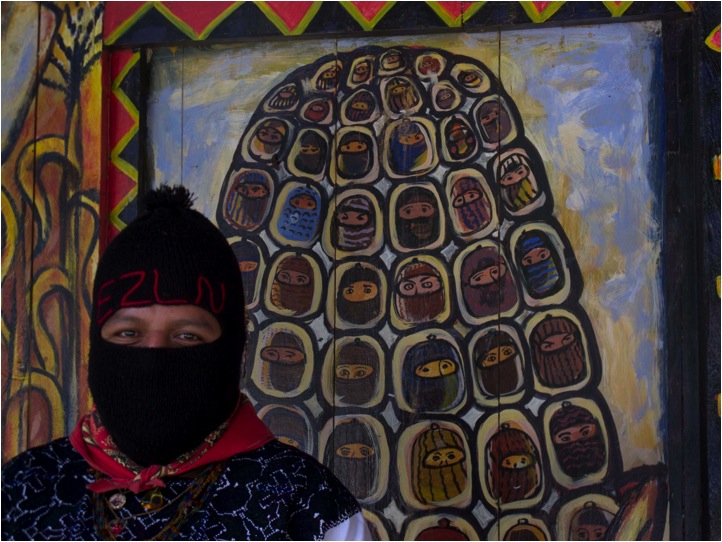

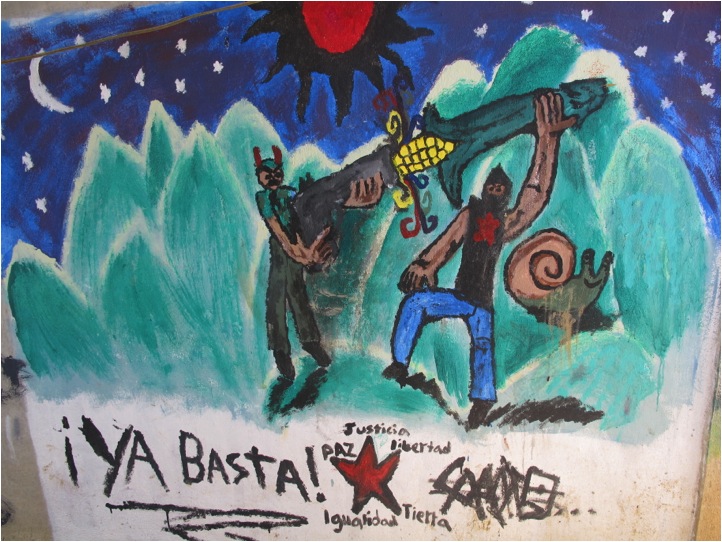
Nosotros: An Interview with a Zapatista
ReadThe caracol, as a social formation, enacts the system of equivalences. Snails carry their homes with them; paintings of and sayings about them encapsulate an entire worldview. Images of snails, often wearing humorous Zapatista masks, make their way into most of the murals, paintings, and textiles.
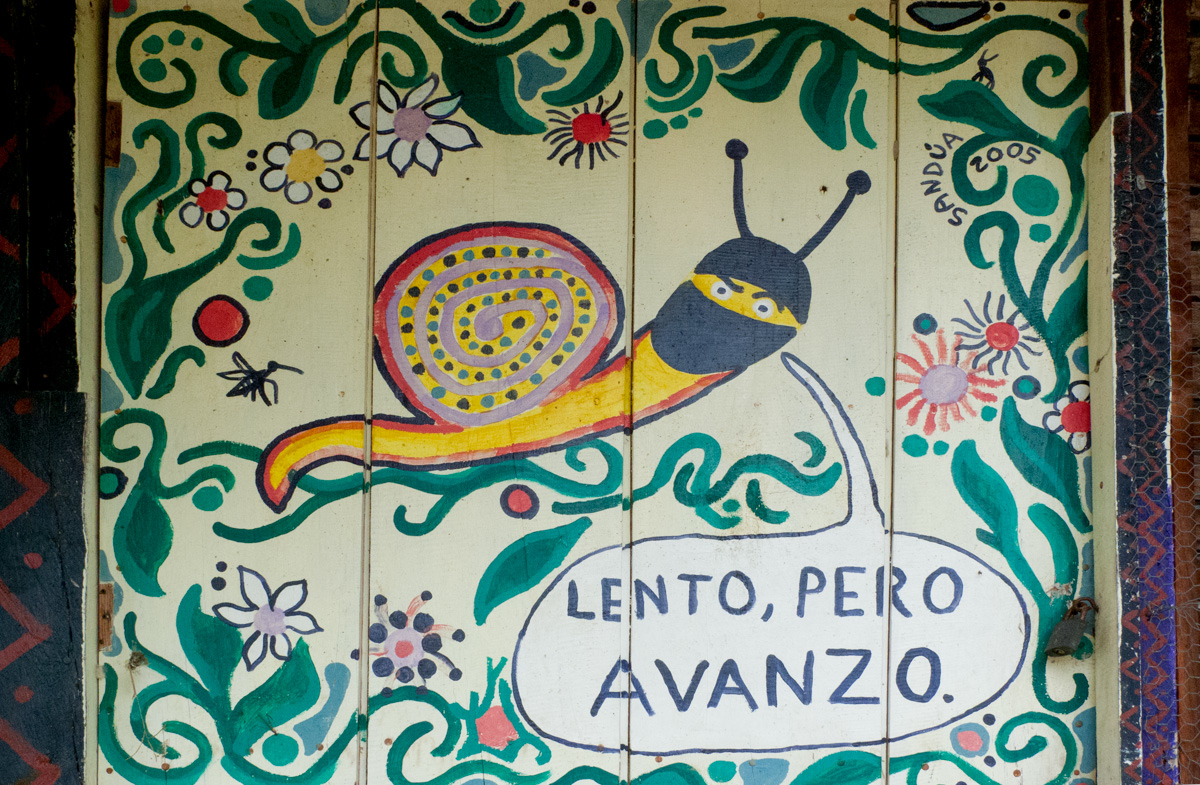
Reflection Four: WE
At that point in the celebration, an unnamed woman, identified only as a member of the Junta del Buen Gobierno, addressed the crowd in Spanish: “Compañeras, compañeros, hermanas y hermanos de la sociedad civil, nacional e internacional.” Ever since the Zapatista uprising, as noted, gender parity has been central to the movement. This work towards parity is reflected not only in all governing roles, official positions, and educational practices, but also in the very language. No masculine-ending word stands without its feminine counterpart: hermanas y hermanos. The compañera from the JBG spoke of the struggles the movement has endured over the years. “It hasn’t been easy,” she admitted, “these ten years of practice and building our autonomy... It hasn’t been easy for many reasons, such as the lack of experience or lack of training in governing and self-governing.”[8]
But the need for resistance continues, she makes clear, confronted as they are by a government that continues to deny them rights and liberty and that wants to take their lands. The Zapatistas, she says, continue to learn how to resist and work for democracy, though the fruits of the struggle will not be visible in their lifetime. The compañera asks people of good heart and good will who compose civil society to support their struggle.
Is she referring to us?
After the compañera finished speaking, another member of the JBG from another region took the microphone and delivered the same speech in Tzeltal. When he was done, another delivered it in Tzotzil. The speeches seemed interminable to me in the downpour. I have not learned to be patient, although I accept that I must exercise patience here. Our feet soaked with water and mud, we made our way towards the main basketball court, the scene of the assembly. I looked down at my shoes in dismay. Vicki, a Chamulan friend and colleague from Fortaleza de la Mujer Maya (FOMMA), a Mayan women’s theater group I had worked with since 1995, walked next to me. I looked down past her broad black lambskin skirt at the small, black, plastic sandals she was wearing. “Aren’t your feet getting soaked?” I asked her. She looked surprised. “It doesn’t matter,” she smiled. “I wear these all the time.” Her feet had no problem getting wet. She would rinse her sandals and dry them off. My nice, sturdy shoes, part of my imaginary intrepid wanderer outfit, no doubt, would be wet and horrible for a long time. The rain muted the sound.
Soon the speeches were over and the flags were marched ceremoniously out of the central space. The next few minutes were all VIVAS! Long live the Escuelita Zapatista! Viva! The vivas! got louder and louder as we reached “Viva las bases de apoyo zapatistas! Viva el subcomandante insurgente Marcos! Viva el subcomandante insurgente Moisés! Viva el Ejercito Zapatista de Liberación Nacional! Viva! Viva Chiapas! Viva México!” Joyous music started up to loud clapping. All the representatives marched off the podium, a long line of women and men walking single file, one after another, in their fine indigenous clothing. I tried to photograph them, but the rain and darkness militated against documentation. The representatives moved quickly, though formally, through the pouring rain up the long road to the entrance of the caracol. The music, very tinny and brassy corridos set to polka-type beats, sung of heroic opponents to "bad" governments.
“In Every Voice a Zapata”: The Zapatista Movement Through Its Corridos
ReadThe party brought together a broad range of people, many of them from other activist networks and grassroots movements. Those accepting Moisés’ invitation became a WE by attending.
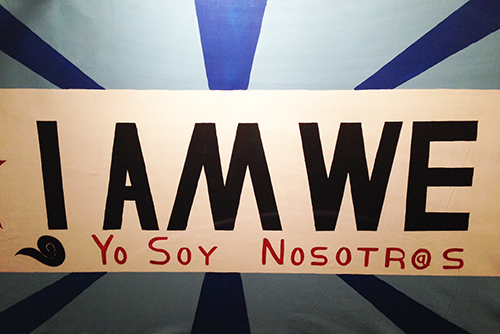
Ricardo Dominguez: Interview about the Zapatista Movement
ReadSystems produce vulnerability, and other systems, networks, and equivalencies can be mobilized to offset some of the debilitating effects and affects. I have come to “listen and learn,” as Subcomandante Marcos good-naturedly asked of us, but I also know how much I have to unlearn in order to listen (2013). The distance between us all continues to be enormous, although many from my group are there, dancing. Presence, presence with, entails a far deeper and more lasting commitment to co-resistance. We cannot fool ourselves that we were among those whom Marcos was waiting for, “those who can see us face to face and greet us and embrace us, and this is how greetings and embraces are done” (2014). We would not be able to see them face to face without ourselves unmasking. But we were there.
The rain, the mud, the poverty does not seem to quell or diminish the pride or determination of the Zapatistas. According to accounts they cite, Zapatista communities have achieved higher standards of health and education than other indigenous communities in Mexico. But Chiapas is still, 20 years later, one of the poorest states in the nation. It has more inequality now than then and higher rates of illiteracy. Carlos Monsiváis, writing as he accompanied the Zapatistas on their 2001 “march for dignity,” noted that, given the obvious and indisputable discrimination in Mexico, demands for state recognition of the right to education, life, health, land seem "utopian" (Mosiváis 1994, 34). The more the Zapatistas move forward, the further the “utopian” ideals of social justice seem to get from them. But they keep struggling. My guess, being there, was that the Zapatistas’ palpable sense of dignity offsets many hardships. As they had shown us, they make their own decisions and rules. Those who seek to interact with them need to abide by them.
The Murals at Oventik: A Photo Essay
ReadThe whole world seems to be represented in the caracoles, even though they fight to stay put: here a flag from the Basque country, here a photo of a Zapatista mural in Belfast, the rainbow flag, a condom wearing a Zapatista mask. When they allow or invite us to enter their territory, are they hoping that we will act as witnesses and transmitters of their existence, their resistance, and their worldview? I say worldview rather than ideology because the Zapatistas are pragmatists, not ideologues. As the evening celebration shows, everyone committed to indigenous rights in the face of the "bad" government is welcome—regardless of the religious, linguistic, and regional tensions that often separate the groups. Indigenous Catholics, Evangelicals, even Muslims who are fighting each other throughout the state are dancing together here. And so are WE all.
And all night and throughout the week, the Mexican Air force buzzed over the caracoles, just in case WE had forgotten that they could.
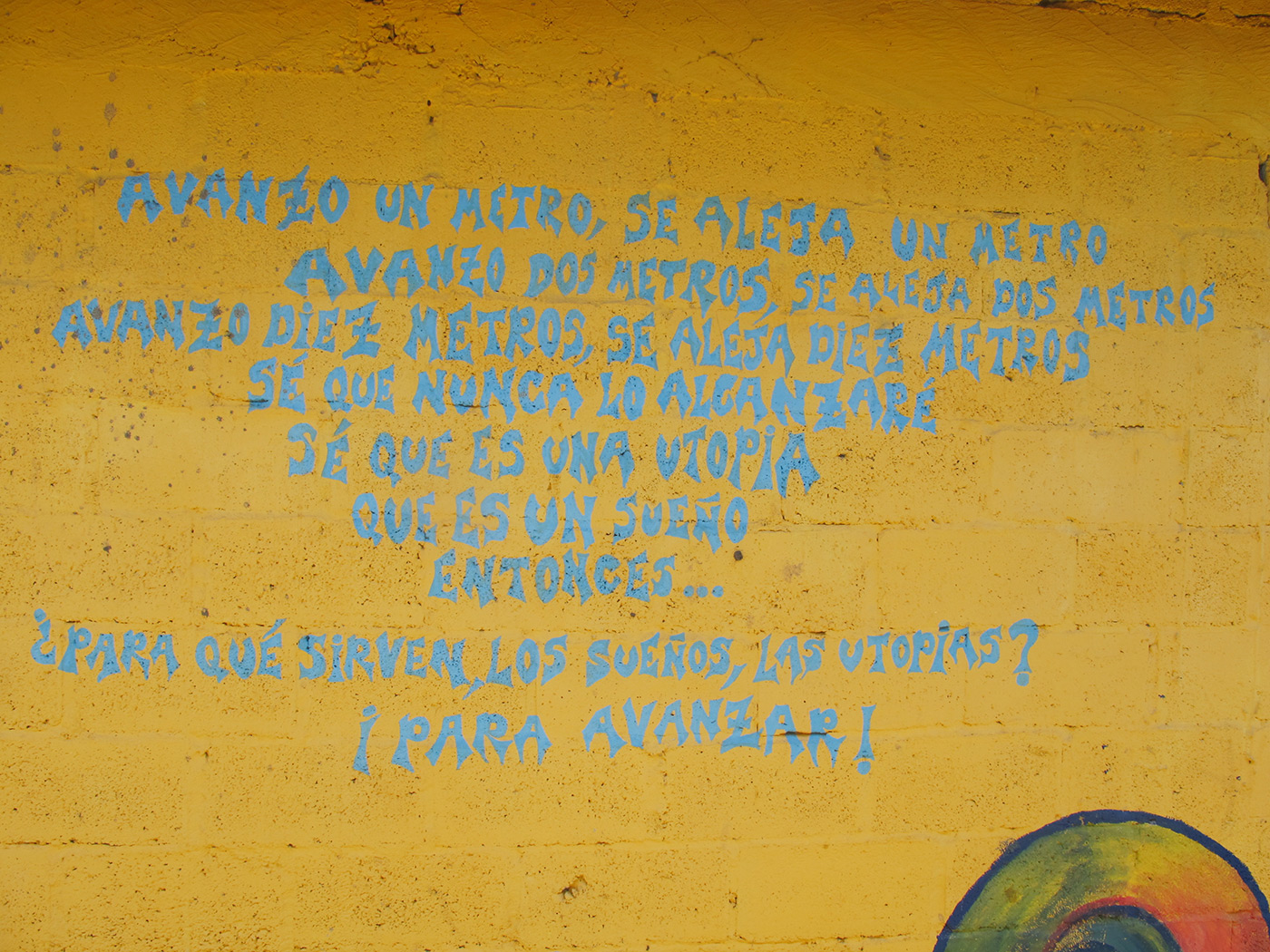
Avanzo un metro, se aleja un metro
Avanzo dos metros, se aleja dos metros
Avanzo diez metros, se aleja diez metros
Sé que nunca lo alcanczaré
Sé que una utopía
Que es un sueño
Entonces…
¿Para qué sirven los sueños, las utopías?
Para avanzar!
I move forward a meter, and it moves away a meter
I move forward two meters, and it moves away two meters.
I move forward ten meters, and it moves away ten meters
I know I will never catch up
I know it’s a utopia
That it’s a dream
So...
What good are dreams? Utopias?
To keep us moving forward!
Avanzo dos metros, se aleja dos metros
Avanzo diez metros, se aleja diez metros
Sé que nunca lo alcanczaré
Sé que una utopía
Que es un sueño
Entonces…
¿Para qué sirven los sueños, las utopías?
Para avanzar!
I move forward a meter, and it moves away a meter
I move forward two meters, and it moves away two meters.
I move forward ten meters, and it moves away ten meters
I know I will never catch up
I know it’s a utopia
That it’s a dream
So...
What good are dreams? Utopias?
To keep us moving forward!

NOTES
[1] The five caracoles are: La Realidad, Roberto Barrios, La Garrucha, Oventic, and Morelia. For more background information on the Zapatista movement see: Womack, John Jr. 1999. Rebellion in Chiapas: A Historical Reader. New York: The New Press. and Saldaña-Portillo, María Josefina. 2003. The Revolutionary Imagination in the Americas and the Age of Development. Durham and London: Duke University Press.
[2] Among the participants were Nora Morales de Cortiñas (President, Asociación Madres de Plaza de Mayo (Línea Fundadora)) and Pablo Gonzáles Casanova (former head of Universidad Nacional Autónoma de México).
[3]Art and Resistance “explores the many ways in which artists and activists use art (performance, mural paintings, graffiti, writing, music) to make a social intervention in the Americas.” The course description is available here: http://hemisphericinstitute.org/hemi/en/summer-2013-mexico
[4] Among the other reasons that Chiapas is so crucial in understanding resistance is that the state’s southern border is the scene of intense migratory movement: thousands of people from Central America cross at this border, often attempting to eventually reach the United States. See: Martínez, Oscar. 2014. The Beast. Trans. Daniela Maria Ugaz and John Washington. New York: Verso.
[5] Thanks to the Bolivian scholar/activist, Silvia Rivera Cusicanqui, for this piece of what she calls “popular metaphysics.” (Cusicanqui 2014).
[6] This echoes Philip Abrams’ observation that “The state is not the reality which stands behind the mask of political practice. It is itself the mask which prevents our seeing political practice for what it is” (1988, 58).
[7] Brian Stross notes the importance of the land and water snails in Mayan glyphs and their significance in their association with both the earth and war: “Because both land snails and water snails are found in the Maya area and have different names, one cannot be sure whether we are dealing with the snail as earth or as underworld, but the ‘war’ expression probably indicates a land snail.” (1991, 105).
[8] Translated by the author from a video of the event. The same speech is cited in “Una década de caracoles” by José Gil and Isaín Mandujano (2013, 34-35).
Abrams, Philip. 1988. “Notes on the Difficulty of Studying the State (1977).” Journal of Historical Sociology 1: 58-89.
de Certeau, Michel. 1984. The Practice of Everyday Life. Translated by Steven Rendall. Berkeley: University of California Press
Cockburn, Alexander and Ken Silverstein. 1995. "Major U.S. Bank Urges Zapatista Wipe-out: 'A Litmus Test for Mexico's Stability.'" Counterpunch 2 (3).
Cusicanqui, Silvia Rivera. 2014. “Micropolítica y zonas de autonomía en los Andes.” Andrés Bello Chair Lecture, King Juan Carlos of Spain Center, New York, February 18.
Deleuze, Gilles. and Guattari, Félix. 1987. A Thousand Plateaus: Capitalism and Schizophrenia. Translated by Brian Massumi. Minneapolis: Minnesota Press.
Gil, Jose and Mandujano, Isaín. 2013. “Una década de caracoles.” Proceso, 25 August. Accessed 30 December 2013.
Holloway, John. 2002. Changing the World without Taking Power: The Meaning of Revolution Today. London: Pluto Press.
Levinas, Emmanuel. 1991. Totality and Infinity: An Essay on Exteriority. Translated by Alphonso Lingis. Dordrecht, Boston, and London: Kluwer Academic Publishers.
Martínez, Oscar. 2014. The Beast. Translated by Daniela Maria Ugaz and John Washington. New York: Verso.
Monsiváis, Carlos. 1994. EZLN: Documentos y comunicados, 5. México DF: Ediciones Era.
Morris, Walter Jr. 2012. A Textile Guide to the Highlands of Chiapas: Guía Textil de los Altos de Chiapas. Colorado: Thrums, LLC.
Nancy, Jean-Luc. 2000. Being Singular Plural. Translated by Robert D. Richardson and Anne E. O’Bryne. Stanford: Stanford University Press.
Saldaña-Portillo, María Josefina. 2003. The Revolutionary Imagination in the Americas and the Age of Development. Durham and London: Duke University Press.
Stross, Brian. 1991. “Classical Maya Directional Glyphs.” Journal of Linguistic Anthropology 1: 97-114.
Scott, James C. 1990. Domination and the Arts of Resistance: Hidden Transcripts. New Haven: Yale University Press.
Subcomandante Marcos. 2013. "Malas y No Tan Malas Noticias." Enlace Zapatista, 3 November. Accessed 30 December 2013. http://enlacezapatista.ezln.org.mx/2013/11/03/malas-y-no-tan-malas-noticias/.
Subcomandante Marcos. 2014. “Between Light and Shadow.” Enlace Zapatista, 27 May. Accessed 30 May 2014. http://enlacezapatista.ezln.org.mx/2014/05/27/between-light-and-shadow
Ríos, Viridiana. 2014. “Chiapas, peor que ayer.” Nexos, 1 January. Accessed 30 December 2014.http://www.nexos.com.mx/?p=15676.
Taussig, Michael. 1999. Defacement: Public Secrecy and the Labor of the Negative. Stanford: Stanford University Press.
Vera, Ramón, ed. 2001. El otro jugador: La caravana de la dignidad indígena. México, La Jornada.
Womack, Jr. John. 1999. Rebellion in Chiapas: A Historical Reader. New York: The New Press.
| Previous page on path | Essays, page 1 of 17 | Next page on path |
Discussion of "Dancing with the Zapatistas"
Add your voice to this discussion.
Checking your signed in status ...